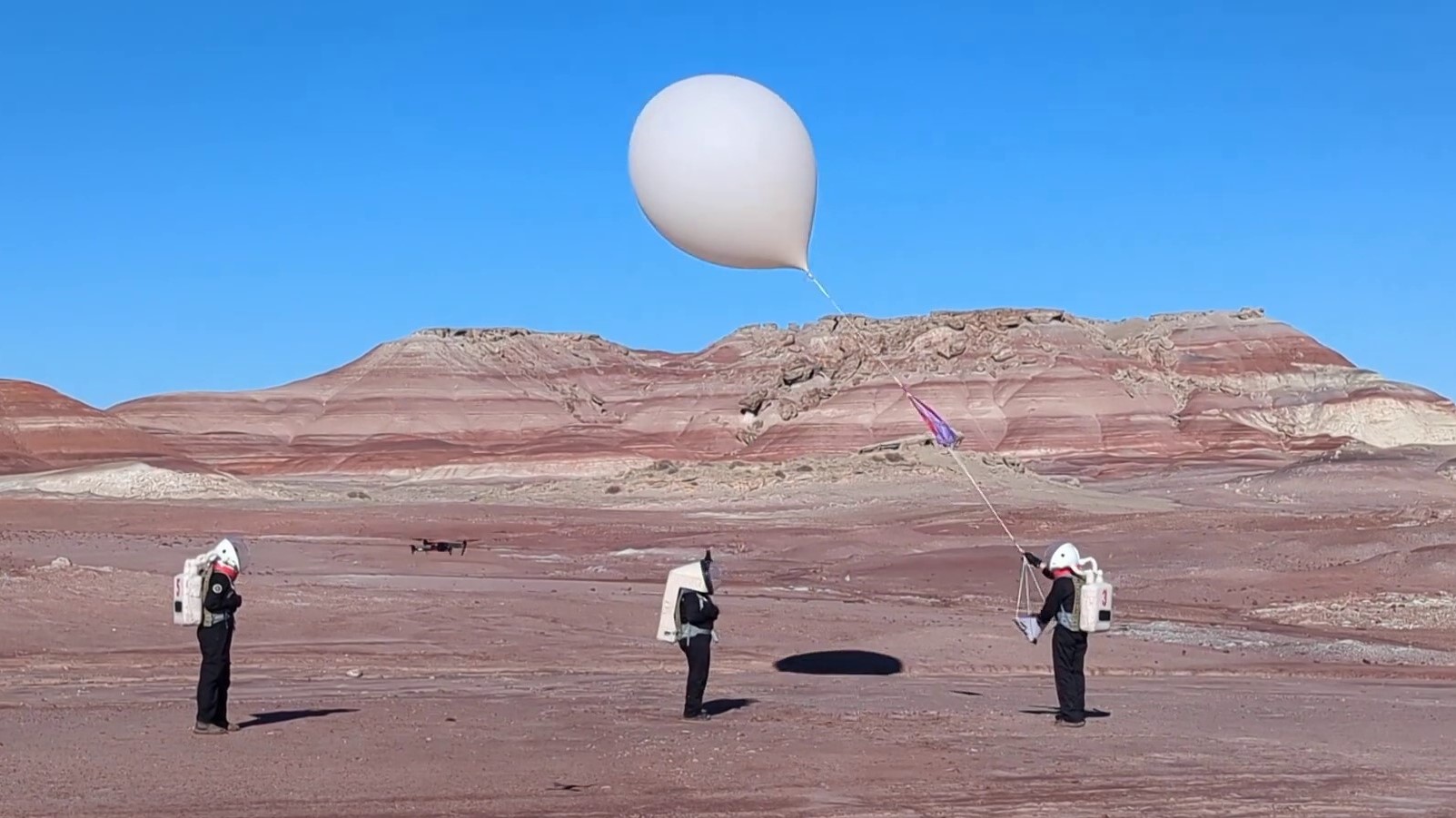(Image credits: MDRS, NASA)
The Aerospace Corporation’s first all-Aerospace analog mission crew embarked on a two-week simulation at The Mars Society’s Mars Desert Research Station (MDRS) in Hanksville, Utah. Last November, the six members journeyed into this remote location with a robust roster of experiments to conduct and a unifying sense of determination to improve their understanding of cislunar and planetary missions.
“Any time you can test something out in the field beyond the comfort zone of the laboratory, you can learn a lot,” said Alli Taylor, MDRS Crew 269 Executive Officer and Senior Project Leader in Aerospace’s Human Exploration and Spaceflight Division. “This opportunity has improved the technology readiness level of individual experiments and is an example of how Aerospace is building skills and strengthening human spaceflight expertise in an operationally relevant environment.”
At the conclusion of their experience in mid-December, the crew returned from the almost-Martian environment with new knowledge, including data from multiple extravehicular activities (EVAs), opportunities to improve in-house technology, and lessons learned for operating and living in space. Beyond the immediate scope of their mission, MDRS Crew 269’s successful simulation validated Aerospace’s ability in providing cutting-edge human space exploration support and paves the way for future opportunities.
“We demonstrated that Aerospace was able to form an astronaut-like crew, recruit high-quality experiments, put together a mission plan, and execute it — all from using expertise and people that we have from within,” said Dr. Kristine Ferrone, MDRS Crew 269 Commander and Senior Engineering Specialist in Aerospace’s Civil Systems Technology Division. “That was something we were pretty sure we could do, but now that we have successfully gone to MDRS, we know for certain we are capable.”

Expediting the Learning Process
Throughout the two weeks at MDRS, the crew performed various experiments both inside the MDRS facilities and outside during EVA exercises, from studying the environment’s impact on mirror coatings and taking regolith samples of the local environment to testing out compact exercise equipment.

The team learned how to adapt and problem solve when confronted with changing weather conditions, technological obstacles, and time constraints.
One major experiment was the testing and deployment of an Aerospace-developed virtual reality and augmented reality prototype.
The crew members collected a variety of images during EVAs to build a three-dimensional model of the MDRS operational space, knowledge that could help guide planning and execution of future EVAs. Testing the prototype in the analog environment revealed areas for improvement not previously known and enabled the crew to start troubleshooting onsite.
“Those two weeks at MDRS were more valuable than the previous six months in the laboratory because we were able to refine the prototype in an expedited fashion,” said Trevor Jahn, MDRS Crew 269 Technology Officer and Senior Member of Technical Staff in Aerospace’s Space Architecture Department. “If I had not brought Project Phantom to the analog, I wouldn't have been able to stress the system and identify areas of weakness. Because we were able to conduct field tests during our mission, the prototype has become exceptionally better.”
Additional experiments included recording radiation measurements during the team’s outdoor exercises — information that was the first of its kind from the MDRS location and added to a shared global database — as well as the deployment of an atmospheric weather balloon.
“People have always proposed balloons on Mars, but it's always been more for a robotic mission application,” said Matthew Eby, MDRS Crew 269 GreenHab Officer and Engineering Specialist in Aerospace’s Engineering and Technology Group. “This experiment explored how deploying a balloon can fit into a human exploration mission. In this case, we measured the dust profile in the atmosphere between ground level and 90,000 feet, something a crew may want to do on Mars if a dust storm occurs.”

Building a Knowledge Base
In addition to conducting their experiments, the crew also experienced what life on another planet may be like: navigating their enclosed living quarters, writing daily mission reports, participating in exercise regiments, and even experiencing delayed communications with friends and family. In their limited downtime, members experienced fellowship through a creative painting project, board games and collaborating on culinary creations. Towards the end of the analog, MDRS Crew 269 hosted a live K-12 STEM event, which reached over 1,100 students nationwide.
For some crew members, this was not their first time participating in an analog mission. Their previous experiences provided them a unique perspective and broadened their view of the different types of analogs that exist.

“The MDRS analog is predominantly focused on operational field tests and provided us with the ability to conduct our experiments in an extreme environment, one that is in many ways very similar to the Martian environment, while wearing mock-up spacesuits,” said Ashley Kowalski, MDRS 269 Crew Engineer and Project Leader in Aerospace’s International Partnerships Division. “SIRIUS-21 — which was a ground-based simulation during which the crew lived and worked in an isolated, confined, hermetically-sealed environment for eight months — was more focused on the psychological, cognitive, physiological, emotional, and mental aspects of long-duration human spaceflight.”
Upon their return the six analog experts are applying their knowledge among the Aerospace community and also sharing their lessons learned through publications and industry events, like the Institute of Electrical and Electronics Engineers 2023 conference. These efforts are ultimately helping Aerospace guide the broader space enterprise into the future.

“Aerospace has expertise across the whole range of space-related activities, from spacecraft design and launch to space operations in cislunar and even interplanetary environments,” said Barbara Braun, MDRS Crew 269 Health and Safety Officer and Principal Director in Aerospace’s Corporate Chief Engineer’s Office. “Aerospace is positioned to be essentially the logistics company for space into the future, and that's increasingly going to include areas like the Moon and Mars. By doing these analog missions and learning what it takes to not only live in space, but explore and work in space, Aerospace will have the capabilities to solve these hard problems.”

